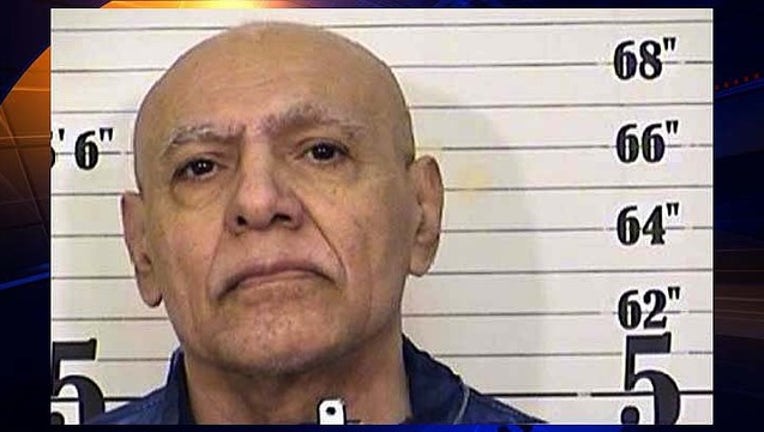Notorious inmate's lawyer says officials knew he was target

Hugo Pinell file photo (Associated Press)
SACRAMENTO, Calif. (AP) -- Hugo Pinell, a notorious killer with ties to the 1960s and 1970s black revolutionary movement, survived 45 years as the longest-serving inmate in California's prison isolation units, partly for his own protection. Just days after he was moved into the general prison population, fellow inmates fatally stabbed him in an exercise yard.
Pinell became infamous for his role as one of the San Quentin 6, where he helped slit the throat of San Quentin prison guards during a failed 1971 escape attempt that killed six.
The 71-year-old, known as "Yogi Bear," was killed Wednesday by two other inmates in an exercise yard at California State Prison, Sacramento, prison officials said. His family may consider a wrongful death lawsuit arguing that prison officials should have known Pinell would immediately be marked for death once he was moved to the general population prison housing unit days ago, his attorney said Thursday.
"He has been a target from just about every group in prison because of his notoriety and what he did years ago," said Keith Wattley, his Oakland-based attorney. "This was foreseeable, which is what makes it so much worse and why the family is looking for answers as to why prison officials let this happen."
Pinell was one of nearly 1,000 inmates moved out of the state's isolation units and into the general population in recent months as the department responded to criticism that too many inmates were being held in solitary confinement, Department of Corrections and Rehabilitation spokeswoman Terry Thornton said.
Thornton said that because the investigation is ongoing she could not respond to the criticism of his transfer to the general prison population, nor say if officials feared for Pinell's safety.
"They don't know why these two inmates attacked him yet," she said. "That's what we hope to learn from the investigation."
The slaying at the maximum security facility east of Sacramento triggered a melee by about 70 other inmates that sent 11 prisoners to outside hospitals with stab wounds, corrections officials said. Five remained hospitalized Thursday, one in critical condition.
Despite spending nearly all of his adult life locked up, Pinell maintained a strong following outside the prison walls.
He wrote long letters posted to a website by supporters, addressing the civil rights movement and the decades of solitary confinement that he likened to being "buried alive," with no contact visits with relatives or friends since December 1970. He was allowed a 15-minute contact meeting to marry a woman, who has since died.
Pinell survived repeated assassination attempts over the years even while he was kept isolated from other prisoners, first in administrative segregation cells and later in Pelican Bay State Prison's security housing unit with other purported gang leaders.
"He's had other prisoners throw bombs into his cell, shoot him with prison-manufactured guns, stab him and otherwise physically attack him," Wattley said. Most were in the 1970s and 1980s, but Pinell had death threats as recently as this year, after he was moved to the prison dubbed "New Folsom" that houses about 2,300 inmates in the suburb 25 miles east of Sacramento.
Many of the assaults and threats were by members of the white supremacist Aryan Brotherhood, which wanted to kill Pinell for his purported involvement in the Black Guerrilla Family prison gang with San Quentin 6 ringleader George Jackson, who was killed in the escape attempt, Wattley said. Pinell long denied any gang connection, but decades ago he led other black inmates who refused to accept some prison policies.
"Being in this kind of confinement is terrible, yes, in many ways, but trying to make it in the streets is harder, more challenging, and we knew that, in the 60s, and that's why we were working hard to change and prepare for the streets reality," Pinell wrote in a letter posted on the website, which includes instructions on how to send him money and cards.
His supporters describe him as a political prisoner and "a revolutionary hero." In his letters, he described learning at San Quentin of the Black Liberation Movement and efforts to improve the lives of black prisoners.
"The story or the image about him and his leadership role morphed into an image of him as a leader of a prison gang, a violent prison gang," Wattley said. "At this point it's hard to discern what is fact and how much is fiction."
Pinell was initially sentenced to life in prison in 1965 for a San Francisco-area rape. He received a second life sentence for killing Correctional Officer R.J. McCarthy in 1971 at the Correctional Training Facility in Soledad, and a third life sentence for the San Quentin escape attempt after he was convicted of assaulting two correctional officers.
He was denied parole 10 times, most recently in May 2014.
Pinell's daughter, Allegra Taylor of Sacramento, would not comment when reached by telephone Thursday.
Pinell immigrated to the United States from Nicaragua as a child, and is also survived by his mother, now in her 90s, and siblings, Wattley said.

